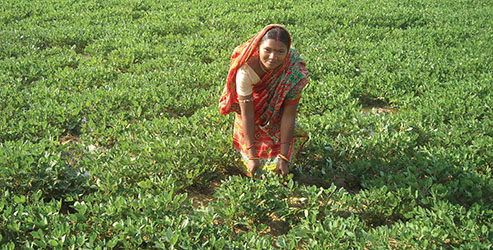Situation Analysis
Red and lateritic zone of West Bengal is characterized by sub-tropical climate with average annual precipitation of 1000-1200 mm (80% of rainfall received during June-September) and temperature range from 16-420C. Land being undulated in nature, tends to erosion of top soil leading to poor status of N, P, K and organic matter. Soil texture is sandy to sandy loam, rich in iron and aluminium but deficient in Ca, Mg, B and Mo. Water retention capacity of soil is poor and pH varies from 5 to 5.5. The area is dominated by cultivation of boro rice in rabi-summer and aman rice in kharif season. Area under boro rice cultivation is decreasing day by day as ground water level is going down every year due to erratic, uneven and scanty rainfall. Still the major cropping pattern of the zone is paddy-paddy-fallow.

A large tract of West Midnapore district comes under such red and lateritic zone where the cropping system is gradually turning into paddy-fallow-fallow. The farmers badly needed a viable option to substantiate the loss due to decrease in area under boro rice cultivation. Sporadically a few farmers tried several other crops and vegetables, but the success of sustainable crop cultivation to replenish boro rice eluded them. A group of farmers from four villages namely Jamrasuli, Dhuliapur, Asthapara and Tura of West Medinipur approached the KVK during 2005-06 seeking advice to find an alternate crop for this areawhich provided an assured return in terms of productivity and marketability. Realizing the magnitudeof the problem, the KVK opted for agro-ecosystem analysis through PRA in the villages to characterizethe present agricultural situation and identify the opportunity to introduce a new crop as per the need of the practicing farmers. Visit, interaction and detailed survey helped the KVK to identify such a crop that would suit the existing climate. Finally, the KVK decided to introduce ‘groundnut’ in the selected villagesas an alternate crop for that area. Detailed meteorological information on humidity, sunlight, cloudy days etc. was also collected from the concerned Department before actually implementing the programme of groundnut cultivation.
Technology, Implementation and Support
In the initial years, the KVK assessed the performance of four varieties of groundnut namely, TPG-41,
TG-26, TG-38 B and TAG-24 in a number of locations of those villages to find out the best suited variety or this identified agro-climatic condition. Varietal evaluation followed the demonstration of measures against seed borne diseases and pest control. Extension functionaries of line departments were involved in the standardization of cultivation process. Finally the KVK came up with the recommendation of complete package for the cultivation of TAG-24 variety with seed treatment of Rhizobium @ 750/ha, soil application of gypsum @ 500 kg/ha after 30 days of sowing and boric acid @2.0 g/l of water after 15 and30 days of sowing followed by foliar application of neem-based liquid 50,000 ppm @0.75 ml/l of water and management of aphid. The package was further demonstrated by KVK through conducting front line demonstrations in 10 ha area during rabi-summer season with TAG-24 variety. The farmers harvested 20q/ha average yield with net return of `25000/ha. The success prompted the KVK to conduct FLD during next kharif season where 12 q/ha and `16000/ha net return could be realized.
Uptake, Spread and Benefits
Gradually horizontal spread of the technology started taking place and within next three years about
150 ha of area could be brought under groundnut cultivation. Requirement of 50-60 acre-inch water through16-20 irrigation for Boro rice cultivation was a severe problem for the farmers. However, cultivation of groundnut was possible only with 10-12 acre-inch water (4-5 irrigations) which was affordable for the farmers. Moreover, cultivation of groundnut has positive impact on soil health, created more man-days and ultimately led to less migration of labour from rural to urban areas. The analysis of soil indicates that pH has been changed to 5.6 from 4.8 followed by increase in available Nitrogen in soil to 210 kg/ha from180kg/ha and available organic matter from 0.5% to 0.75%. During the period, additional man days created was to the tune of 10500 numbers which has resulted in 30% reduced migration of labour. Groundnut hasa good market in West Medinipur as well as neighboring districts also which enabled the farmers to get instant return and encouragement for groundnut cultivation. Cultivation of groundnut has not confined to West Medinipur district. Farmers of identical agro-climatic situations in Purulia and Bankura districtsalso have started adopting groundnut in place of boro rice.
(Source: Krishi Vigyan Kendra, West Medinipur, West Bengal)







फेसबुक पर लाइक करें
यूट्यूब पर सदस्यता लें
X पर फॉलो करना X
इंस्टाग्राम पर लाइक करें